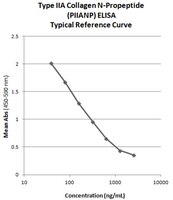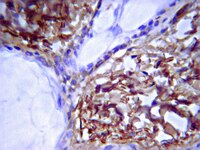EZPIIANP-53K MilliporeType IIA Collagen N-Propeptide (PIIANP) ELISA
Recommended Products
Overview
| Replacement Information |
|---|
Key Spec Table
| Analytes Available | Species Reactivity | Key Applications | Detection Methods |
|---|---|---|---|
| PIIANP | H | ELISA | Fluorescent Colorimetric |
| References |
|---|
| Product Information | |
|---|---|
| Detection method | Fluorescent Colorimetric |
| Precision, % |
|
| Quality Level | MQ200 |
| Applications | |
|---|---|
| Key Applications |
|
| Application Notes | Room temperature, 3 hour assay 10 µL sample size |
| Physicochemical Information | |
|---|---|
| Sensitivity |
|
| Linearity of Dilution | 91–109% |
| Standard Curve Range |
|
| Dimensions |
|---|
| Materials Information |
|---|
| Toxicological Information |
|---|
| Safety Information according to GHS |
|---|
| Safety Information |
|---|
| Product Usage Statements | |
|---|---|
| Usage Statement |
|
| Storage and Shipping Information |
|---|
| Packaging Information | |
|---|---|
| Material Size | 96-well strip plate |
| Transport Information |
|---|
| Supplemental Information |
|---|
| Specifications |
|---|
| Global Trade Item Number | |
|---|---|
| Catalogue Number | GTIN |
| EZPIIANP-53K | 04053252337451 |
Documentation
Protocols
| Title |
|---|
| Protocol- EZPIIANP-53K |
Type IIA Collagen N-Propeptide (PIIANP) ELISA SDS
| Title |
|---|
References
| Reference overview | Pub Med ID |
|---|---|
| Tissue structure modification in knee osteoarthritis by use of joint distraction: an open 1-year pilot study. Femke Intema,Peter M Van Roermund,Anne C A Marijnissen,Sebastian Cotofana,Felix Eckstein,Rene M Castelein,Johannes W J Bijlsma,Simon C Mastbergen,Floris P J G Lafeber Annals of the rheumatic diseases 70 2011 Show Abstract Full Text Article | 21565898
 |
Technical Info
| Title |
|---|
| 96 well Template 2 Up |
| 96 well Template Single |
| Quality Control Range Sheet- PIIA-116 and PIIA-216 |
| Quality Control Ranges: PIIANP ELISA |
User Guides
| Title |
|---|
| User Guide-EZPIIANP53K |








